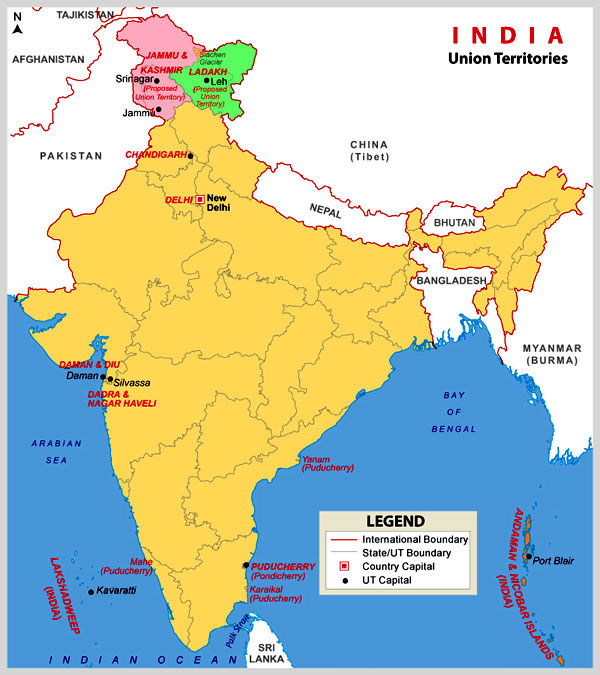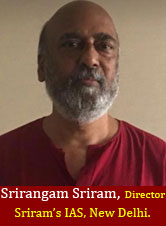How the language question led to reorganization of states in independent India? (150 words)
Sakshi Education
By Srirangam Sriram, Sriram's IAS, New Delhi.


Under pressure from powerful protest movements, the government had to bifurcate the state of Bombay into Maharashtra and Gujarat. In the trilingual (Punjabi, Hindi, and Pahari) state of Punjab, demand for a separate Punjabi Suba gained prominence. Finally, in 1966, Punjab was divided into two Punjabi and Hindi speaking states of Punjab and Haryana.
Thus, until 1960s, the linguistic reorganization of India was largely completed. States’ reorganization did not, however, resolve all the problems related to linguistic conflicts. Important factor to note is that linguistic reorganization of the states has not in any manner adversely affected the unity of the country rather strengthened it.

After independence, India achieved territorial integration, maintaining the unity of India. But reorganizing a pluralist society into an integrated administrative unit now proved to be a challenge, as controversies over the issue of a national language and linguistic regionalism had begun to raise their heads.
The Indian National Congress in its 1920 session in Nagpur had decided to recognize regional linguistic identities and divided India into 21 linguistic units for its organizational purposes. But the British had constituted administrative units without any consideration for linguistic homogeneity; and as a result, administrative units like the Madras Presidency contained four linguistic groups – Tamil, Telugu, Kannada and Malayalam - leading to varying senses of domination and relative deprivation. Hence, there were demands for linguistic reorganization of the provinces.
Despite huge public support in favour of creating the four southern linguistic provinces of Andhra, Kerala, Karnataka and Maharashtra, the Dar commission set up in 1948 opposed such a move in the interest of national integration.
In 1948, Congress’s own Linguistic Provinces Committee, with Jawaharlal Nehru, Vallabhbhai Patel and PattabhiSitaramayya in its report popularly known as JVP report also opposed the creation of linguistic provinces. Their preference was for composite states with no particular parochial identities, but constituted on the basis of administrative convenience and economic viability.
The first demand for a linguistic province was raised by the Telugu-speaking people of Andhra. In 1951, Swami Sitaram and later PotttiSriramulu, started a fast unto death in support of the demand for a separate Andhra state. PotttiSriramulu lost his life in protest which led to violent clashes and political upheaval. In this background, Government of India decided to create the new state of Andhra in 1953.
Under popular pressure, a states’ reorganization commission was constituted in 1953. While recommending the formation of sizeable composite states with self-sustaining economies, it ultimately gave in to the demand for linguistic states. The states’ reorganization act of 1956 constituted fourteen states.
Reorganization of states in 1956:
The Indian National Congress in its 1920 session in Nagpur had decided to recognize regional linguistic identities and divided India into 21 linguistic units for its organizational purposes. But the British had constituted administrative units without any consideration for linguistic homogeneity; and as a result, administrative units like the Madras Presidency contained four linguistic groups – Tamil, Telugu, Kannada and Malayalam - leading to varying senses of domination and relative deprivation. Hence, there were demands for linguistic reorganization of the provinces.
Despite huge public support in favour of creating the four southern linguistic provinces of Andhra, Kerala, Karnataka and Maharashtra, the Dar commission set up in 1948 opposed such a move in the interest of national integration.
In 1948, Congress’s own Linguistic Provinces Committee, with Jawaharlal Nehru, Vallabhbhai Patel and PattabhiSitaramayya in its report popularly known as JVP report also opposed the creation of linguistic provinces. Their preference was for composite states with no particular parochial identities, but constituted on the basis of administrative convenience and economic viability.
The first demand for a linguistic province was raised by the Telugu-speaking people of Andhra. In 1951, Swami Sitaram and later PotttiSriramulu, started a fast unto death in support of the demand for a separate Andhra state. PotttiSriramulu lost his life in protest which led to violent clashes and political upheaval. In this background, Government of India decided to create the new state of Andhra in 1953.
Under popular pressure, a states’ reorganization commission was constituted in 1953. While recommending the formation of sizeable composite states with self-sustaining economies, it ultimately gave in to the demand for linguistic states. The states’ reorganization act of 1956 constituted fourteen states.
Reorganization of states in 1956:
- The Telangana area of Hyderabad state was transferred to Andhra;
- Kerala was created by merging the Malabar district of the old Madras Presidency with Travancore-Cochin.
- Certain Kannada-speaking areas of the states of Bombay, Madras, Hyderabad and Coorg were added to the Mysore state.
- Bombay state was enlarged by merging the states of Kutch and Saurashtra and the Marathi-speaking areas of Hyderabad with it.

Under pressure from powerful protest movements, the government had to bifurcate the state of Bombay into Maharashtra and Gujarat. In the trilingual (Punjabi, Hindi, and Pahari) state of Punjab, demand for a separate Punjabi Suba gained prominence. Finally, in 1966, Punjab was divided into two Punjabi and Hindi speaking states of Punjab and Haryana.
Thus, until 1960s, the linguistic reorganization of India was largely completed. States’ reorganization did not, however, resolve all the problems related to linguistic conflicts. Important factor to note is that linguistic reorganization of the states has not in any manner adversely affected the unity of the country rather strengthened it.
Published date : 28 Oct 2020 02:28PM













